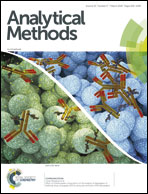A novel pyrene based highly selective reversible fluorescent-colorimetric sensor for the rapid detection of Cu2+ ions: application in bio-imaging†
Abstract
A novel pyrene derivative containing a benzilmonohydrazone moiety has been prepared following a facile synthetic procedure and exploited for the selective detection of Cu2+ under four different channels (colorimetric, absorption, emission and bio-imaging). In the presence of Cu2+, the chemosensor L provided a significant fluorescence enhancement with an easily detectable colour change from yellow to colourless, whereas other metal ions produced only minor changes in colour or fluorescence intensity. The sensitivity of the fluorescence based assay is 7.8 nM for Cu2+, which is far below the limit mentioned in the World Health Organization (WHO) guidelines for drinking water. 1H NMR data, the Job plot and the ESI-MS spectrum prove 1 : 1 stoichiometric complexation between L and Cu2+. The sensing behaviour of the probe has also been well supported by DFT studies. Receptor L exhibits remarkable detection ability in a wide pH range of 4–11 and is successfully utilised in the determination of Cu2+ in real samples. Moreover, L shows its application potential in the detection of Cu2+ in living cells.



 Please wait while we load your content...
Please wait while we load your content...